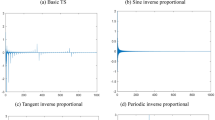Abstract
Physarum can form a higher efficient and stronger robust network in the processing of foraging. The vacant-particle model with shrinkage (VP-S model), which captures the relationship between the movement of Physarum and the process of network formation, can construct a network with a good balance between exploration and exploitation. In this paper, the VP-S model is applied to design a transport network. We compare the performance of the network designed based on the VP-S model with the real-world transport network in terms of average path length, network efficiency and topology robustness. Experimental results show that the network designed based on the VP-S model has better performance than the real-world transport network in all measurements. Our study indicates that the Physarum-inspired model can provide useful suggestions to the real-world transport network design.
Access this chapter
Tax calculation will be finalised at checkout
Purchases are for personal use only
Preview
Unable to display preview. Download preview PDF.
Similar content being viewed by others
References
Bozzone, D.M.: Cells With “Personality” Physarum Polycephalum. Carolina Tips 64(3), 9–11 (2001)
Nakagaki, T., Yamada, H., Tóth, A.: Maze-Solving by an Amoeboid Organism. Nature 407(6803), 470 (2000)
Nakagaki, T., Yamada, H., Hara, M.: Smart Network Solutions in an Amoeboid Organism. Biophys. Chem. 107(1), 1–5 (2004)
Nakagaki, T., Kobayashi, R., Nishiura, Y., Ueda, T.: Obtaining Multiple Separate Food Sources: Behavioural Intelligence in the Physarum plasmodium. P. Roy. Soc. B-Biol. Sci. 271(1554), 2305–2310 (2004)
Tero, A., Takagi, S., Saigusa, T., Ito, K., Bebber, D.P., Fricker, M.D., Yumiki, K., Kobayashi, R., Nakagaki, T.: Rules for Biologically Inspired Adaptive Network Design. Science 327(5964), 439–442 (2010)
Adamatzky, A.: Bioevaluation of World Transport Networks. World Scientific Publishing Company, Singapore (2012)
Reid, C.R., Beekman, M.: Solving the Towers of HanoiHow an Amoeboid Organism Efficiently Constructs Transport Networks. J. Exp. Biol. 216(9), 1546–1551 (2013)
Tero, A., Kobayashi, R., Nakagaki, T.: A Mathematical Model for Adaptive Transport Network in Path Finding by True Slime Mold. J. Theor. Biol. 244(4), 553–564 (2007)
Adamatzky, A.: Physarum Machines: Encapsulating Reaction Diffusion to Compute Spanning Tree. Naturwissenschaften 94(12), 975–980 (2007)
Jones, J.: The Emergence and Dynamical Evolution of Complex Transport Networks from Simple Low-Level Behaviours. Int. J. Unconv. Comput. 6(2), 125–144 (2010)
Gunji, Y.P., Shirakawa, T., Niizato, T., Haruna, T.: Minimal Model of a Cell Connecting Amoebic Motion and Adaptive Transport Networks. J. Theor. Biol. 253(4), 659–667 (2008)
Tsompanas, M.-A.I., Sirakoulis, G.C., Adamatzky, A.I.: Evolving Transport Networks with Cellular Automata Models Inspired by Slime Mould. IEEE Trans. Cybern. PP(99), 1–13 (2014)
Aono, M., Hara, M.: Spontaneous Deadlock Breaking on Amoeba-Based Neurocomputer. Biosystems 91(1), 83–93 (2008)
Gunji, Y.P., Shirakawa, T., Niizato, T., Yamachiyo, M., Tani, I.: An Adaptive and Robust Biological Network Based on the Vacant-particle Transportation Model. J. Theor. Biol. 272(1), 187–200 (2011)
Schneider, C.M., Moreira, A.A., Andrade, J.S., Havlin, S., Herrmann, H.J.: Mitigation of Malicious Attacks on Networks. PNAS 108(10), 3838–3841 (2011)
Author information
Authors and Affiliations
Corresponding author
Editor information
Editors and Affiliations
Rights and permissions
Copyright information
© 2015 Springer International Publishing Switzerland
About this paper
Cite this paper
Liu, Y., Gao, C., Liang, M., Tao, L., Zhang, Z. (2015). A Physarum-Inspired Vacant-Particle Model with Shrinkage for Transport Network Design. In: Tan, Y., Shi, Y., Buarque, F., Gelbukh, A., Das, S., Engelbrecht, A. (eds) Advances in Swarm and Computational Intelligence. ICSI 2015. Lecture Notes in Computer Science(), vol 9140. Springer, Cham. https://doi.org/10.1007/978-3-319-20466-6_8
Download citation
DOI: https://doi.org/10.1007/978-3-319-20466-6_8
Published:
Publisher Name: Springer, Cham
Print ISBN: 978-3-319-20465-9
Online ISBN: 978-3-319-20466-6
eBook Packages: Computer ScienceComputer Science (R0)




